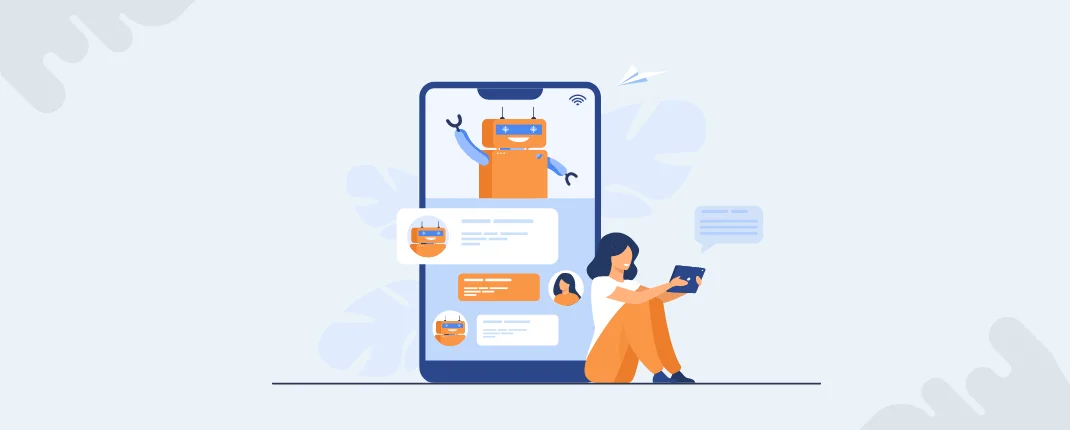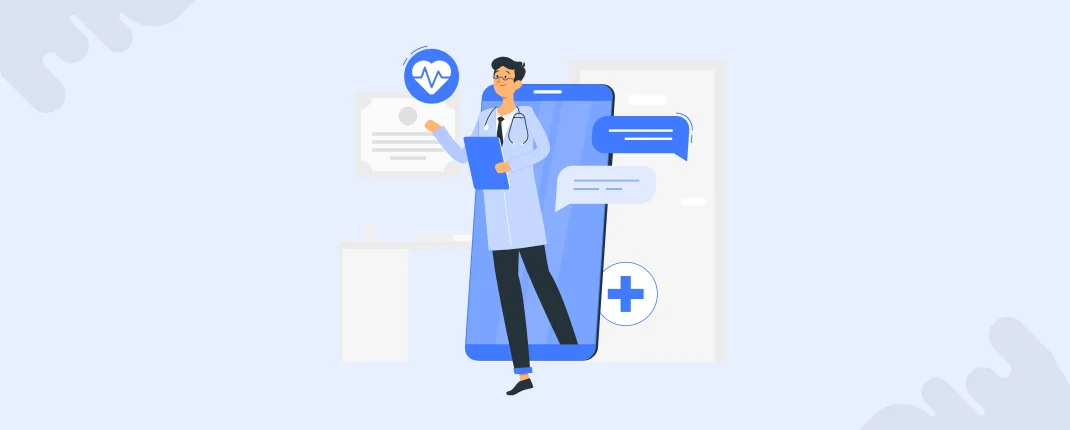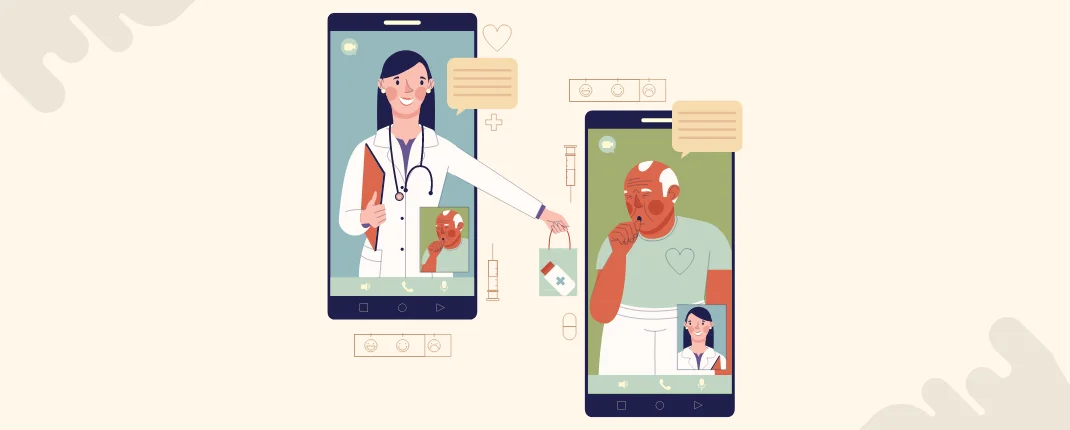
Himanshi Arora
7 min read
Introduction
Ever thought about having a computer friend help you with health questions? That's exactly what AI-powered medical chatbots do! These clever chatbots are changing how we connect with health information. This article is your ticket to understanding and building one of these nifty chatbots using OpenAI, a super-smart tool for computers.
We'll chat about why these smart pals are so cool for healthcare, why OpenAI is the go-to choice for making them, and, step by step, we'll figure out how to create one. Imagine having a friendly companion that gets health stuff and talks to you like a buddy. That's what we're aiming for using the brainpower of OpenAI. Excited to make your own health-savvy sidekick? Let's jump into the world of smart health assistants!
What is Medical Chatbot

A medical chatbot is a computer program using AI and natural language processing to engage users in health-related conversations. It offers instant support, information, and even helps with tasks like appointment scheduling, making healthcare more accessible through technology.
Benefits of Medical Chatbot
In the realm of healthcare, the integration of AI chatbots, specifically designed as medical chatbots, presents a myriad of advantages. Leveraging cutting-edge AI technology, such as OpenAI chatbots, holds the key to transforming healthcare accessibility and patient engagement.
-
Instant Support and Information
Medical chatbots, powered by AI technology, provide users with immediate support and accurate medical information. Whether it's answering health queries or offering guidance on symptoms, these chatbots excel in delivering timely assistance.
-
Streamlining Healthcare Interactions
The implementation of AI chatbots in the medical field streamlines interactions by simplifying tasks like appointment scheduling. This not only enhances efficiency but also contributes to a more seamless patient experience.
-
Personalized Engagement
Building an AI chatbot tailored for medical purposes allows for personalized engagement. By utilizing Medical AI, these chatbots can understand user needs and preferences, creating a more user-centric and efficient healthcare interaction.
-
24/7 Accessibility
Medical chatbots, driven by AI technology, operate round the clock, providing users with continuous accessibility to health-related information and support. This ensures that individuals can receive assistance whenever they need it, fostering a responsive healthcare environment.
-
Cost-Effective Healthcare Solutions
The ability to build an AI chatbot for medical purposes introduces cost-effective solutions. These chatbots can handle routine tasks, freeing up healthcare professionals to focus on more complex cases, thereby optimizing resource utilization.
-
Enhanced User Experience
Incorporating AI technology, especially with OpenAI chatbots, elevates the overall user experience. The natural language processing capabilities of these chatbots enable human-like interactions, making healthcare information more approachable and user-friendly.
The creation and integration of AI-powered medical chatbots bring forth a range of benefits, from instant support and streamlined interactions to personalized engagement and cost-effective healthcare solutions. Embracing AI technology in the development of medical chatbots signifies a leap towards a more accessible, efficient, and user-centric healthcare landscape.
Types of AI Chatbot in Healthcare

In healthcare, AI chatbots come in various types, each serving specific purposes to enhance patient care and streamline medical processes. Here are some notable types of AI chatbots in healthcare:
-
Informational Chatbots
These chatbots are designed to provide users with general health information, answer frequently asked questions, and offer guidance on wellness practices. They act as informative resources, making health-related knowledge more accessible.
-
Appointment Scheduling Chatbots
AI chatbots in this category assist users in scheduling medical appointments, managing calendars, and sending reminders. They contribute to the efficient organization of healthcare services and reduce the administrative burden on medical staff.
-
Symptom Checker Chatbots
Symptom checker chatbots use AI algorithms to assess user-reported symptoms and provide preliminary insights into potential health conditions. While not a substitute for professional diagnosis, these chatbots can offer initial guidance.
-
Medication Management Chatbots
Focused on medication adherence, these chatbots help users manage their medication schedules, provide dosage reminders, and offer information about potential side effects. This type aims to improve patient compliance and overall health outcomes.
-
Mental Health Support Chatbots
AI chatbots designed for mental health support offer a conversational platform for users to express their feelings, receive emotional support, and access resources for mental well-being. They contribute to the growing field of digital mental health solutions.
-
Language Translation Chatbots
Particularly useful in diverse healthcare settings, language translation chatbots assist in overcoming language barriers between healthcare providers and patients. They facilitate effective communication, ensuring everyone can access and understand crucial health information.
-
Post-Discharge Follow-up Chatbots
After a patient is discharged from a healthcare facility, these chatbots continue the conversation by checking in on the patient's recovery progress, providing post-treatment guidance, and addressing any concerns that may arise during the recovery period.
-
Health and Fitness Coaching Chatbots
AI chatbots in this category focus on promoting healthy lifestyles by offering personalized fitness and nutrition advice. They engage users in goal-setting, monitor progress, and provide continuous support to encourage positive lifestyle changes.
Steps to Build an AI Chatbot Using Open AI

Building an AI chatbot using OpenAI involves several key steps. Here's a concise guide to help you get started:
-
Define Objectives
Clearly outline the goals and functionalities of your AI chatbot. Determine its purpose, target audience, and the specific tasks it will perform, such as answering queries, providing information, or facilitating transactions.
-
Gather Data
Collect relevant data to train and fine-tune your chatbot. This data should include examples of user interactions, responses, and any specific information related to the chatbot's intended domain. Ensure compliance with data privacy regulations.
-
Choose OpenAI Model
Select an appropriate OpenAI model for your chatbot. GPT (Generative Pre-trained Transformer) models are often suitable for natural language understanding and generation. Consider the complexity of your chatbot's tasks when choosing the model.
-
Train the Model
Use the gathered data to train your chosen OpenAI model. Fine-tune the model to align with the nuances of your desired conversational style and specific domain. This training process helps the chatbot understand and generate contextually relevant responses.
-
Implement Natural Language Processing (NLP)
Enhance your chatbot's conversational abilities by integrating Natural Language Processing techniques. This allows the chatbot to understand user intent, context, and nuances, leading to more effective and engaging interactions.
-
Develop User Interface (UI)
Design a user-friendly interface for your chatbot. This might involve developing a web-based interface, a mobile application, or incorporating it into an already-existing platform. Make certain that the UI promotes seamless interactions and delivers a favorable user experience.
-
Integrate APIs
If your chatbot needs to connect with external services or databases, integrate the necessary APIs (Application Programming Interfaces). This could include accessing information from healthcare databases, e-commerce platforms, or any other relevant sources.
-
Test and Iterate
Thoroughly test your chatbot in different scenarios to identify and address any issues. Solicit feedback from users and iterate on the model and interface to enhance performance and user satisfaction.
-
Implement Security Measures
Prioritize the security of user data. Implement encryption, authentication, and authorization measures to safeguard sensitive information processed by the chatbot. Ensure compliance with data protection regulations.
-
Deploy and Monitor
Deploy your AI chatbot to the desired platform or channels. Monitor its performance in real-world scenarios, gather user feedback, and continuously refine the chatbot to improve its accuracy and effectiveness over time.
By following these steps, you can develop a functional and effective AI chatbot using OpenAI, catering to your specific objectives and providing valuable interactions for users.
Cost to Develop Medical AI Chatbot

Providing an exact cost for developing a Medical AI chatbot is challenging without specific project details. However, for a basic version with standard features, you might expect a starting cost of around $30,000 to $50,000.
For more complex and feature-rich chatbots with advanced functionalities, the cost can range from $50,000 to $100,000 or more.
However, Here's a breakdown of potential cost factors:
-
Development Team
The expertise and location of the development team play a significant role in cost. Development rates vary across regions, and hiring a skilled team with experience in AI and healthcare will impact overall expenses.
-
Features and Complexity
The complexity and features of the Medical AI chatbot, such as natural language processing, integration with healthcare databases, appointment scheduling, or symptom analysis, will influence development costs. More sophisticated functionalities generally require more development time and resources.
-
Data Security and Compliance
Ensuring data security and compliance with healthcare regulations is crucial. Implementing robust security measures and adhering to privacy standards may involve additional development efforts, contributing to overall costs.
-
User Interface (UI) Design
The design and user interface of the chatbot contribute to the overall user experience. Investing in a well-designed and user-friendly interface may increase development costs but can enhance user engagement and satisfaction.
-
Testing and Quality Assurance
Thorough testing is essential to ensure the accuracy and reliability of the chatbot. Budgeting for testing and quality assurance processes contributes to the overall cost of development.
-
Maintenance and Updates
Post-launch, ongoing maintenance, and updates are necessary to address any issues, incorporate user feedback, and keep the chatbot up-to-date. Factoring in long-term maintenance costs is important for the sustainability of the Medical AI chatbot.
Future of Chatbots in Healthcare
The future of chatbots in healthcare holds tremendous promise, driven by ongoing advancements in technology and a growing recognition of the benefits they bring to the healthcare ecosystem. Here are key aspects shaping the future of chatbots in healthcare:
-
Integration with Wearables and IoT Devices
Future chatbots will seamlessly integrate with wearables and Internet of Things (IoT) devices, allowing for the collection of real-time health data. This integration enhances the accuracy of health assessments and provides a more comprehensive view of patients' well-being.
-
Virtual Health Assistants
Chatbots will evolve into comprehensive virtual health assistants, assisting users with medication management, appointment scheduling, and wellness advice. They will become integral components of holistic healthcare delivery, providing continuous support beyond traditional clinical settings.
-
Language Translation Services
Language translation chatbots will become more sophisticated, breaking down language barriers in healthcare settings. This ensures that individuals from diverse linguistic backgrounds can communicate effectively with healthcare providers, improving accessibility and inclusivity.
-
Mental Health Support
The role of chatbots in mental health support is expected to grow. These chatbots will offer empathetic and non-judgmental conversations, providing users with a confidential platform to express their feelings, receive emotional support, and access mental health resource.
-
AI-Driven Diagnostics
The integration of advanced AI algorithms in chatbots will enable more sophisticated diagnostic capabilities. Chatbots may assist in preliminary assessments of symptoms, offering users insights into potential health conditions and guiding them towards appropriate medical interventions.

How Whitenapp Solutions Help You to Build AI Powered Medical Chatbots Using Open AI
In this blog, we've talked about three main things: how much it costs to make a medical chatbot using open AI, what things affect the cost, and what are the steps to build a medical chatbot.
No matter what kind of chatbot you want to develop, these are the main things that decide how much it will cost. You'll need a special team of tech people who know about this stuff, good business information, the right tools, and to use the OpenAI magic for your project.
If you're thinking about making a chatbot like this, we're here to help. We're a trusted group of tech people who know all about OpenAI. We've made over 300 custom softwares for people from all around the world. Let’s get in touch for your project and get a first consultation free!
Frequently Asked Questions
-
Can I create my own OpenAI?
OpenAI, the creator of ChatGPT, has recently introduced a method that enables individuals to develop their own iteration of ChatGPT, referred to as GPTs. This allows you to construct a customized version tailored to your specific business or personal objectives within a short span of time.
-
How can I ensure the privacy and security of healthcare information when using an AI-powered medical chatbot?
Protecting user data is a priority. When building a chatbot, it's crucial to adhere to healthcare regulations and implement robust security measures. OpenAI provides guidelines on data handling, and it's essential to follow best practices to guarantee the confidentiality and integrity of healthcare information processed by the chatbot.
-
Why choose OpenAI for building a medical chatbot?
OpenAI is a leader in artificial intelligence technology, offering robust tools and models that make creating sophisticated chatbots easier. Their models, like GPT (Generative Pre-trained Transformer), are excellent for natural language understanding and generation, making them ideal for crafting chatbots that can interact intelligently and naturally.
-
What exactly is an AI-powered medical chatbot, and how does it work?
An AI-powered medical chatbot is a computer program designed to have conversations about health-related topics. Using OpenAI's technology, these chatbots understand language and context, allowing them to provide information, answer questions, and even engage in discussions about medical issues. Think of it as a smart virtual assistant for healthcare.

